Vol 1 No. 12 TROPIC LIGHTNING NEWS May 20, 1966
Index
[The 1966 Vietnam issues of Tropic Lightning News were published in Saigon,
and are of lower quality than later years that were printed in Japan. Over
the years the photographs and text have faded and it has been difficult to
reproduce them. Even when the photos are unclear, I have been included
them to give a sense of the activities in the Division.]
2nd Brigade Gets New CO
Lieutenant Colonel Thomas M. Tarpley
took command of the 2nd Brigade of the 25th Infantry Division Monday in brief
ceremonies at Cu Chi.
Col. Tarpley, the former commanding officer of the Rear Detachment
(Provisional), 25th Infantry Division, replaces Colonel Lynnwood M. Johnson who
assumed command of the 2nd Bde. almost two years ago, in July 1964. Col.
Johnson has returned to Schofield Barracks, Hawaii.
Col. Tarpley accepted the brigade flag under cloudy skies from Lt. Col.
Milton H. Hamilton, 2nd Bde. executive officer. After inspecting the honor
guard, Col. Tarpley said he was "delighted to be here and have the opportunity
to serve you in the coming months."
After the ceremonies, Col. Tarpley was congratulated by Major General Fred C.
Weyand, division commanding general.
"Col. Tarpley has served with the division since August, 1963, when he became
commander of the 1st Battalion (Mech.), 5th Infantry. In August 1965, he became
assistant chief of staff, G-1, and, in March 1966, became commanding officer of
the division's rear detachment.
The colonel was graduated from the United States Military Academy in 1944.
He has degrees in Russian history from the University of Maryland and in
International affairs, from George Washington University.
Col. Tarpley is also a graduate of the Command and General Staff College, Ft
Leavenworth, Kans., the Army War College, at Carlisle Barracks, Pa., and The
Infantry School. Ft. Benning, Ga. He has been awarded the Bronze Star Medal,
Combat Infantryman's Badge, American Defense Service Medal, American Campaign
Medal, World War II Victory Medal, National Defense Service Medal, and the
American Occupation Medal.
The colonel served as a platoon leader with the 263rd Infantry in Europe
doing World War II. He was graduated from the Command and General Staff College
at Fort Leavenworth in 1954.
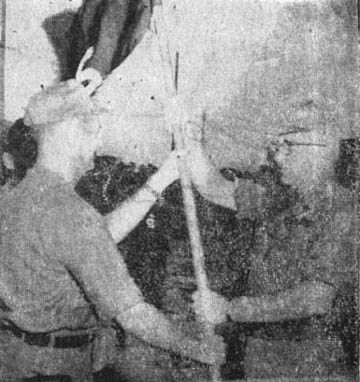 |
CHANGE - Lt. Col. Thomas M. Tarpley (right) receives the brigade colors from Lt. Col. Milton H. Hamilton in change of command ceremonies at 2nd Brigade headquarters. |
Wolfhounds Mark Birthday
Organization days in Vietnam usually pass without fanfare. So it would have
been for 1st Battalion, 27th Infantry, and its sister unit, the 2nd Battalion,
had it not been for Lieutenant Colonel Harley F. Mooney Jr., commander of
1/27th.
Since his "Wolfhounds" were busy on an operational mission, Col. Mooney
directed a cake be baked to mark the unit's 64th anniversary. Presented to
Major Nguyen Van Nha, Hau Nghia Province chief, the cake bore the legend, "Happy
Anniversary," in both English and Vietnamese.
The May 14th ceremony made official note of the Wolfhounds' birthday, which
fell on May 2.
Constituted in 1813, the 27th reckons its history from 1901, when it was
activated at Plattsburgh Barracks, N.Y.
Only 14 months later, the regiment was in action quelling the Philippine
Insurrection. Remaining for heavy action throughout the Philippines until 1904,
the 27th returned to the United States to be headquartered at Ft. Sheridan, Ill.
Called back into action in 1906, the unit was dispatched to Cuba at the
request of the Government there to help put down a Cuban insurrection. The
civil war was brought under control by Cuban forces and the 27th returned to the
States in 1908.
Rushed to Texas City, Tex., in 1912, the 27th spent several years patrolling
the Mexican-American border to guard against continued skirmishes which had been
taking place there.
Returned to the Philippines in 1915, the regiment stayed on duty there until
the Bolshevik revolution in Russia in 1918 saw the troops of several countries
sent to maintain order.
It was while on duty in Siberia that the 27th was given the nickname
"Wolfhounds," a grudging compliment paid by the Russians for the regiment's
reputation for fierce fighting. The nickname came from the borzoi, or Russian
wolfhound, a dog reputed to be gentle with its friends and fierce with its
enemies. The name stuck and, in October 1952, the 27th became the first Army
regiment to have its nickname made an official part of its designation.
The 27th Infantry Regiment was incorporated into the 25th Infantry Division
when the division was organized in 1941 and became the first American unit to
engage the attacking Japanese on December 7.
Fighting with the division through island-hopping operations in the Pacific,
the Wolfhounds earned the Philippine Presidential Unit Citation for action in
1944 and 1945.
The war over, the division began more than four years of occupation duty in
Japan. It was while the Wolfhounds were headquartered outside of Osaka that
they began supporting the Holy Family Home, a Catholic orphanage. Contributions
since then have amounted to almost half a million dollars.
Sweeping into Korea with the "Tropic Lightning" Division in 1950, the 27th
Infantry acquired a second nickname for a series of campaigns throughout the
peninsula: "General Walton Walker's Fire Brigade."
Fighting through ten campaigns in Korea, the regiment was credited with
killing more than 3,000 of the enemy in one year of fighting there. The
Wolfhounds hold four American distinguished unit citations and the Republic of
Korea Presidential Unit Citation for combat from 1950 to 1954.
The regiment returned to Hawaii with the rest of the division in 1954 and
became 1st and 2nd Battalions, 27th Infantry, when the ROAD (Reorganization,
Army Divisions) concept was instituted in 1963.
The Wolfhounds, as part of the division's 2nd Brigade, landed in Vietnam in
January 1966.
Lt. Col. Feir Becomes 2/35th Commander
Lieutenant Colonel Philip R. Feir assumed command of the 2nd Battalion, 35th
Infantry, in change-of-command ceremonies at Pleiku.
Men of the "Cacti Blue," one of the three maneuver battalions of the 3rd
Brigade Task Force, stood in formation as the outgoing commander, Lieutenant
Colonel George A. Scott, of Mobile, Ala., gave his farewell talk.
Col. Scott has commanded 2/35th since August 1964. In his parting comments,
he recalled many events the battalion had taken part in over the last 23 months,
including jungle training at Schofield Barracks, preparation for deployment.
movement to Vietnam and four months of fighting Viet Cong.
The incoming commander, formerly 3rd Bde. executive officer, accepted the
colors and his new command from Col. Scott and spoke to his men for the first
time. He remarked on the outstanding record of the 2/35th and emphasized his
pride in becoming a part of the battalion.
Guests at the ceremony included Major General Fred C. Weyand, division
commander, and Brigadier General Glenn D. Walker, brigade task force commander.
Col. Scott is being assigned to I Field Forces, Vietnam, headquarters at Nha
Trang, in the G-3 section.
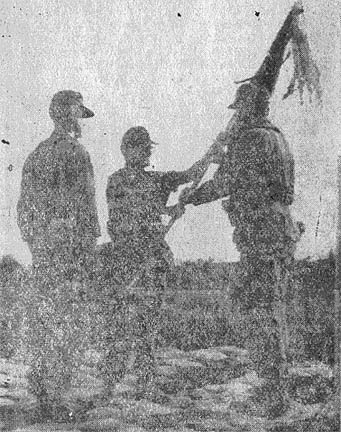 |
NEW CO - Lt. Col. Philip R. Feir assumes command of 2nd Bn., 35th Infantry, from Lt. Col. George A. Scott in ceremonies conducted at 3rd Brigade. Battalion Sergeant Major William R. Franklin looks on. (Photo by Sutphin) |
Excess Leave Studied By House Committee
The House Armed Committee is currently studying a proposal to authorize
servicemen in a combat zone to accumulate more than sixty days leave by the end
of the fiscal year.
Introduced in January and referred to committee, the measure would permit
individuals serving in a combat zone to carry excess leave from one fiscal year
to another.
The term combat zone is flexible in this case, however, and must be defined
by the President. One official observed that "Vietnam definitely is included"
in the consideration.
According to the measure, the excess leave must be used within the following
fiscal year after it has been accrued.
Under current procedures, all leave over 60 days is lost at the end of the
fiscal year, regardless of an individual's place of assignment.
To date, the full membership of the House has not yet acted on the proposal.
| FETED - Birthday cake and congratulations were passed as Lt. Col. Harley F. Mooney Jr. (r.), 1/27th commander, and 1st Sergeant Robert W. Hawkins, battalion sergeant major, presented a cake to Major Nguyen Van Nha, Hau Nghia Province chief. Lieutenant Colonel Clay T. Buckingham, senior adviser for Section Headquarters, Hau Ngtiia Province, (2nd from right) also was on hand to mark the Wolfhound's 64th anniversary. (Photo by Hanson) |
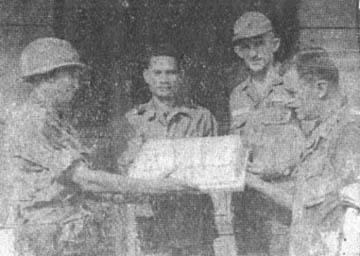 |
Page 2 TROPIC LIGHTNING NEWS May 20, 1966
Lest We Forget - Memorial Day
Memorial Day is essentially a somber day. It is a day devoted to honoring
those who died in their nation's defense. Its outward aspects are speeches,
parades, and other public events. And across the nation, Americans tidy up
grave sites and decorate them with flowers and little flags. Such gestures pay
honor outwardly to those men, while at the same time other Americans the world
over pause to pay silent tribute to them.
For members of the armed forces, Memorial Day is also a day of rededication.
So whether fighting the Viet Cong in a Vietnamese swamp, maintaining the freedom
of West Berlin, or signing up recruits in a mid-western town, servicemen can
honor other and earlier fighting men by rededicating themselves to their purpose
and their duties. By carrying out those duties to the best of their ability,
they will be keeping faith with past, present, and future generations of
Americans. This not only will honor the dead but will also help assure the
eventual victory of democracy over communism.
Memorial Day, also known as Decoration Day, was first observed officially on
May 30, 1868, by the Grand Army of the Republic, an organization of Union
veterans of the Civil War.
Although originally dedicated to the memory of the Union dead, Memorial Day
has become a day in which the nation pays homage to its dead of all wars. It is
a Federal legal holiday and a legal holiday in most of the States.
To members of the Armed Forces, Memorial Day has a special meaning. It
focuses attention on our magnificent military tradition and inspires pride in
it. It reminds us of those who died at Valley Forge, Gettysburg, San Juan Hill,
Belleau Wood, Bastonge, Tarawa, Pork Chop Hill, and Ia Drang Valley. These men
died for an important cause, and it is the same cause to which today's
servicemen are committed: freedom.
The cold war going on today is unlike any other war we know. It is a total
conflict. It must be fought with mental and moral as well as physical weapons.
The adversary may or may not be in uniform. He may use conventional or
unconventional weapons and tactics.
While the tactics and guises of communism take many forms and are often
obscure, one fact remains constant and clear - the ultimate goal of communism is
world domination, and as such is a direct threat to the freedom which we
cherish.
So bear in mind during the observance of this Memorial Day that the day is
also symbolic of the greater trial - the survival of freedom itself - facing you
and every other free man and woman in the world today. This trial demands
steadfast courage, firm conviction, deep faith in the cause of freedom. It
requires the patience and willingness to outstay and to overcome the forces of
communism that are attempting to destroy democracy and to banish liberty from
the face of the earth - replacing them with total tyranny and oppression.
Know Your Enemy
Liberation Front Gives Viet Cong
"Legitimacy"
Literally translated, the phrase Viet Cong (VC) means Vietnamese Communist,
and those who are Viet Cong employ the whole Communist arsenal of deceit and
violence.
A Viet Cong is a man, woman or child - a tough fighter, with words or
weapons, for what he is taught to call the "liberation" of South Vietnam - the
Republic of Vietnam. Viet Cong also applies to the military and civilian
components of the "Front" (National Front for the Liberation of South Vietnam,
or (NFLSVN). To its deluded followers the Front is the government they serve -
but to the vast majority of South Vietnamese it is an instrument of terror and
oppression manipulated by the Communists of North Vietnam.
The Viet Cong, the Communist "Liberation Army" within the Republic of Vietnam
has expanded its numbers enormously, despite increasingly heavy casualties. Its
so-called main force has grown from about 10,000 men in 1960 to over 75,000.
Several regiments of the North Vietnamese Army have been sent by Hanoi into
South Vietnam as part of the Communist buildup of forces in the south. As
befits "regulars," many are armed with late-model, imported weapons and wear
uniforms, helmets of wicker or steel, and even scarves for unit identification.
From isolated companies their formations have grown to battalions and regiments.
The strength of the Viet Cong guerrillas has not increased as rapidly. The
estimated more than 100,000 guerrillas and militia, mostly based in the vicinity
of their home villages and hamlets, are essential to the success of the main
force and to the whole Viet Cong effort. Better armed and trained than before,
the irregulars still wear the "calico noir," the traditional black pajamas of
the Vietnamese peasant (worn also by the regulars as fatigue uniforms). They
guide, support, reinforce and provide recruits for the "liberation" movement.
They also make possible the rule of the Communist Party in the countryside,
enforcing the dictates of the local puppet Front organizations.
There are substantial areas in which the Front is the only effective
government. It operates schools and hospitals, clothing factories and
arsenals. Millions of Vietnamese support the Front out of friendship or fear,
most often the latter.
Due largely to the militia and the secret agents of the Party, an estimated
one-fourth of the people of South Vietnam pay taxes to the Front, even though
they may also pay taxes to the legitimate government. This is an impressive
record for a shadow government.
Editorial: Vietnam Games Are Deadly for
Players
Three men from one unit in the Tropic Lightning Division recently stole a
vehicle, drove it through the barriers of the perimeter and went into the
village of Cu Chi after dark. On their way back to the base camp, about 600
meters from the main gate, the vehicle was ambushed by Viet Cong with small arms
fire and grenades. One soldier was killed and two rifles and one pistol were
abandoned and captured. The vehicle was damaged by rifle fire.
The incident is not representative of soldiers in the Tropic Lightning
Division but it brings to the foreground the need to emphasize certain orders
and instructions and the consequences of violating them.
In the first place, soldiers have been instructed not to leave the base camp
at night unless participating in military operations. Of the three who violated
these instructions, one paid with his life and the other two are subject to
courts-martial for violating an order and AWOL. They are also subject to
courts-martial for misappropriation of a vehicle.
Secondly, soldiers on duty in bunker positions on the base perimeter have
been instructed not to permit individuals or groups of men to leave the base
camp at night, unless participating with a unit on a military operation.
The three soldiers who left the base camp that night drove past two manned
bunkers and a tank overlooking the camp's main entry. By failing to challenge
or stop the vehicle as it left the perimeter, the rnen on duty in the bunkers
and the tank contributed to the chain of events that led to the loss of life and
equipment.
Had any one of the soldiers involved in this one incident followed the proper
orders and instructions, the man killed in the Viet Cong ambush would be alive
today.
| Reminder: To take advantage of free mailing privileges, the word "free" must be written in your own hand writing. |
CHOPPER PILOT MISSES BY SEAT OF PANTS
The co-pilot of a HU1D (Huey), a captain, sat tightly in his seat as the
speeding chopper approached for a landing at Trang Bang, a quiet village eight
miles west of Cu Chi.
The huey, one of the many just arriving from the United States for 25th
Aviation Battalion use, featured a new, 168-pound, armor-plated, steel seat.
That seat literally saved the co-pilot's seat.
Automatic weapons fire from a Viet Cong sniper sent one bullet through the
floor of the low-flying chopper. It bounced off the bottom of the captain's
seat and ricocheted off to the rear. There were no casualties.
The armor-plated seat had received its first test under fire and the captain
took it sitting down.
|
Last One |
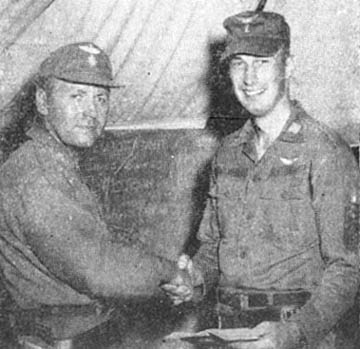 |
NFW RANK - Lt. Charles L. Kendall is shown with Maj. Ernest C. Elliott, commanding officer, Company A, 25th Aviation Battalion, at ceremonies promoting him to his present rank. (Photo by Pardue). |
Aviation Marks End of Era With Promotion of
Lieutenant
The division's 25th Aviation Battalion has lost its last second lieutenant.
First Lieutenant Charles L. Kendall was recently promoted to his present rank in
ceremonies at Cu Chi. The silver bar was pinned on by Major Ernest C. Elliott,
Company A commander.
Promotions in the aviation battalion from second to first lieutenant are
uncommon because of the amount of time it takes to finish required schooling.
Most aviators enter the battalion as first lieutenants.
Lt. Kendall arrived in Vietnam with 175th Aviation Company on April 10.
Prior to joining the Army, he was graduated from the University of Alabama in
1964, with a degree in civil engineering.
| The TROPIC LIGHTNING NEWS is an
authorized publication of the 25th Infantry Division. It is published
weekly for all division units in the Republic of Vietnam by the
Information Office, 25th Infantry Division, APO U.S. Forces 96225. Army
News Features, Army Photo Features and Armed Forces Press Service material
are used. Views and opinions expressed are not necessarily those of the
Department of the Army. Printed in Saigon, Vietnam, by Dai Doan Ket
Publishing Company. Maj. Gen. Fred C. Weyand . . . . Commanding General Maj. William C. Shepard . . . . . . Information Officer 2nd Lt. Patrick J. McKeand . . . Officer-in-Charge Sp5 Dale P. Kemery . . . . . . . . . Editor |
Page 3 TROPIC LIGHTNING NEWS May 20, 1966
China, Optics Draw High Duty Fees
(Editor's Note: This Is the second of two articles concerning U.S.
Customs laws.)
In shipping goods back to the United States, it should be remembered that
duty is charged on a percentage basis of the purchase price. The exact figures
vary from item to item, depending upon the type of merchandise being imported
and its value. Even various makes and/or models of the same kind of product
vary in duty charges.
Chinaware is possibly one of the most singularly expensive items to import in
terms of duty. Individuals special-ordering china from exchanges in Vietnam or
elsewhere should show a copy of their orders to permit exchange officials to
ship the glassware to the United States under reduced tariff rates. In some
eases, china may be admitted duty free - if a act of orders accompanies the
merchandise. Otherwise, duty on china runs between 45 and 60 per cent of the
purchase price.
Tape recorders and high fidelity accessories generally are assessed 15 per
cent of the purchase price, while radios bear a duty of 12 1/2 per cent.
Unstrung pearls may cost only five per cent duty while permanently strung pearls
can cost between 30 and 55 per cent of the original cost to import. Binoculars
will cost a flat 30 per cent to import, telescopes 22 1/2 per cent, while other
optical goods, excluding cameras, will be assessed an import duty of between 30
and 50 per cent. Motion picture projectors bear a duty of 35 per cent. You
will pay 12 1/2 to 19 per cent for brassware, but the cost may increase to 25
per cent for bambooware. Wearing apparel varies in duty costs, depending upon
the type of material used.
It is unwise to attempt to fool Customs officials for they are well aware of
human nature and can easily spot many individuals attempting to smuggle goods
into the United States. Penalties are stiff and are seldom worth the small
savings which could be realized from failing to declare merchandise.
Cameras average between 15 and 25 per cent duty, though usually the lower
figure is assessed for returning service personnel. Beware of the brand of
camera you plan to ship for Pentax and Nikon are not the only two which are
illegal to import by mail. If you are planning such shipment, it would be well
to contact Customs officials to learn which cameras, are protected by tariff
barriers.
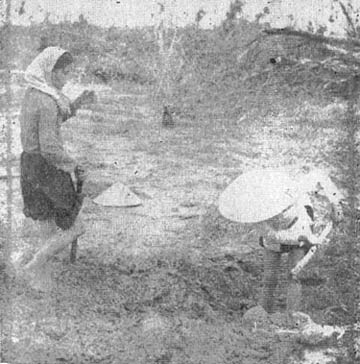 |
Vietnamese women from the village of Tan An Hoi were invited to the division's base camp to dig up valuables they had buried is the area. |
At Cu Chi
Villagers Get Valuables From
Hidden Caches
Dust swirled around the wheels of the large military trucks as they hurried
from the village of Tan An Hoi to Cu Chi. Trucks that usually carry division
troops to search-and-destroy operations this time carried 49 excited Vietnamese
women on a different kind of operation.
The operation was named "Project Reclamation" and was conducted to allow
women in the Cu Chi area to dig up valuables they had buried in the base camp
area.
After a three-mile ride they pulled to a stop. The women hopped off and
grabbed their homemade digging tools. Old neighbors began to group and assist
one another on the search.
Many started digging within a few feet of the truck while others roamed
through the rows of tents, looking for a familiar landmark.
In their musical chatter they decided the exact spots to dig. They remained
for three hours digging and pulling their buried wealth from the earth. When
their search was over, they had gathered more than ten tons of rice, about fifty
dollars in Vietnamese currency and an unestimated amount of gold and jewelry.
Project Reclamation was a civic action program conducted by Division
Artillery at the request of the villagers who formerly lived in this area.
| Unsafe Acts Make Accident Facts. Drive as if your life depended on it - it does. |
1/27th Road Service Open 24 Hours Daily
If you were driving through Los Angeles, Chicago or Philadelphia and your car
suddenly developed engine trouble, a mechanic probably would be just a phone
call away.
But when you're driving an armored personnel carrier through the village of
Duc Lap, and something suddenly goes wrong, road service is hardly around the
next corner.
The 1st Battalion, 27th Infantry, on the recent operation Maili have found
what they consider the best solution to the problem.
Master Sergeant Bethel W. Kelly, of Los Angeles, heads one of several
maintenance teams which, as Kelly puts it, "can fix just about anything in the
field."
"We try to keep a supply of parts we need most right within the maintenance
team, and we can always have special parts flown in by helicopter," he adds.
There are five other mechanics on Kelly's maintenance team, and all go
prepared to repair wheeled vehicles. There is also a four-man team from the
725th Maintenance Battalion ready to handle tracked vehicles.
Sgt. Kelly says, "We have from two to five vehicles coming in every day -
with everything from flat tires to burned out spark plugs. So far, we've only
had one we couldn't fix."
The maintenance shop never sleeps in the field. It's open 24 hours a day to
handle any vehicle which needs repair. "Our job is to keep them rolling," Kelly
explains simply.
Snake Jolts Relaxing 1/27th Captain
It was a hot day, and Captain Ardeen Foss, of Sioux Falls, S.D., settled
under a scraggly clump of bamboo to wait for the armored personnel carriers to
come along.
He had been leading the men of Company C, 1st Battalion, 27th Infantry,
through the rice paddies of Hau Nghia Province all morning and was ready to
return to the base camp of operation Maili.
The clump of bamboo trees offered the only shade available, and shade was
important because in Vietnam it can mean a 20-degree difference in temperature.
Capt. Foss had just gotten comfortable, with his back against the tree, when
suddenly something wriggled free from the leaves above him.
He looked shocked, and for good reason. The 'something' was a five-foot-long
bamboo viper, a deadly snake, and it had fallen right onto his chest.
As the captain describes it, "I did a back flip and jumped away. The snake
took off in the other direction. I grabbed my M-16 and chased him. Now I've
got a snake skin."
With the snake, added to a collection of dogs, chickens, iguanas and monkeys,
division troops should be ready to open up their own zoo soon.
65th ENGRS. PAUSE IN REPAIR WORK
Company D, 65th Engineer Battalion, set out on operation Longfellow to repair
bridges between Pleiku and the village of Dak To. They made it all right - but
it took awhile.
As they advanced along Highway 14 to prepare roads for convoys of the 3rd
Brigade, the men were approached by a French missionary asking for assistance in
building houses in a nearby Montagnard village.
The engineers quickly went to work using power saws and cut more than 200
trees for logs, which were used as stilts and framework. They stayed to help
the villagers erect their homes.
On another occasion, they found themselves under sniper fire and were pinned
down for nearly two and one-half hours before forcing the enemy to break
contact.
Despite the "spur-of-the-moment" activities, the engineers managed to repair
a total of more than 60 bridges, large and small, on the stretch of road between
the two Vietnamese towns.
Air Medal Goes To 3/4 Cavman For V-N Service
Specialist Four Bobby Taylor, a tank driver for Troop B, 3rd Squadron, 4th
Cavalry, was awarded the Air Medal with three Oak Leaf Clusters for
participating in sustained aerial flight while a member of the division's
"Shotgun" program last year.
Taylor actively participated in more than 100 aerial missions over hostile
territory in support of combat ground forces of the Republic of Vietnam. During
all of these missions he displayed the highest order of air discipline in spite
of the hazards inherent in repeated aerial flights.
Lieutenant Colonel John R. Hendry, 3/4 Cav. commander, made the presentation
during ceremonies at Cu Chi.
2/32nd Artillery Occupies Posh Cu Chi Club
When the United States establishes an Army base on the moon, one of the first
buildings to go up undoubtedly will be an enlisted men's club.
The 2nd Battalion, 32nd Artillery, thinking six months in advance, won the
race for leisure space recently at Cu Chi.
The unit, using "sundry funds," began saving for the club more than six
months ago.
The survey section, taking no more than one month and one day from start to
finish, built the club under the supervision of Sergeant First Class Richard E.
Slead, Moline, Ill.
Because of an asbestos-pad ceiling and bamboo walls, the club keeps out much
of the midday heat. "It's the coolest place in the battalion," one battery
commander said.
And it's also the most elegant. The club, which seats 72 at capacity, has
Oriental lamps hanging from the ceiling, new chairs and tables with beautiful
formica tops.
One long bar, manned by Specialist Five Gary Dinsmore, of Minneapolis, Minn.,
and Specialist Five Ralph Pulliam, of Archie, Mo., serves up the soft drinks and
the beer.
A new stereo recorder plays soft music in the background.
Specialist Four Joseph Fallon, a technician who has since returned to the
United States, was credited for installing the floor and frame, and Staff
Sergeant Norman E. Bates, of Martinsburg, Iowa,, put in he wiring.
"About the only thing it doesn't have," one enlisted man said, "are
waitresses."
Page 4 TROPIC LIGHTNING NEWS May 20, 1966
Long thought to be terrain good only for the infantryman, Vietnam is
giving itself up to the onslaughts of armored personnel carriers, armor and
aerial support.
APCs from 1st Battalion (Mechanized), 5th Infantry, have proved valuable in
moving advancing infantry through areas in which the Viet Cong have laid broad
anti-personnel mine fields.
The heavy tanks of 69th Armor, the Army's first in Vietnam, loom formidably
on the horizon in division operations, furnishing a quick ride for infantrymen,
harmlessly detonating anti-personnel mines and performing the classic armor role
of general infantry support with the firepower of 90mm cannons.
Unique to Vietnam and its specialized warfare has been the
extensive use of helicopters. The choppers are used to move troops into
place behind enemy positions and supply quick reaction forces to areas under attack.
The workhorse of 25th Aviation Battalion's arsenal is the UH1D ("Huey"), which
flies aerial fire support, resupply missions, medical evacuations and virtually
any other job where speed and maneuverability are essential.
It is a different war, requiring new tactics and new weapons. But it is not
so different that the methods and weaponry of past wars cannot punish the Viet
Cong effectively.
|
125th Sig. Bn. Photos |
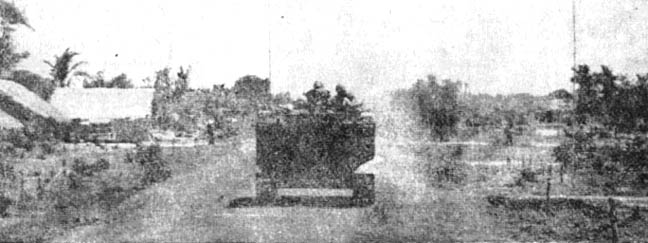 |
| 1/5th APC rattles on a road-clearing mission north of Cu Chi as curious villagers turn out to watch "Tropic Lightning" soldiers in action. |
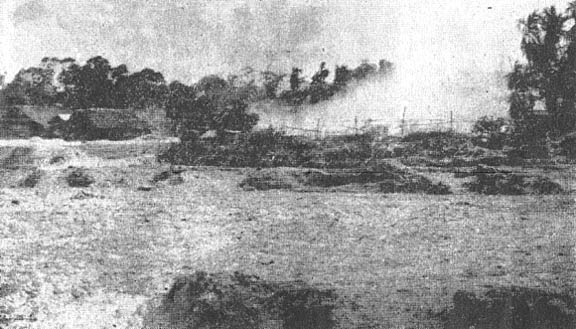 |
| The foot soldier receives strong support from the might of 69th Armor as "Black Panther" tanks kick up dust in moving toward beleaguered infantry positions. |
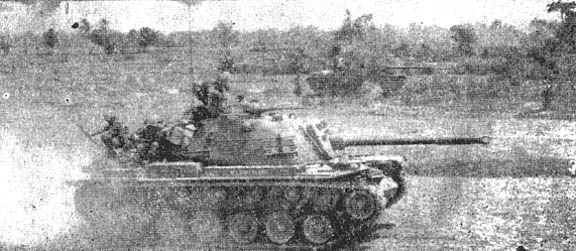 |
| Infantrymen from 1st Battalion, 27th Infantry, slide from a 69th Armor tank during operation Makaha. Armored column had moved into position to strike enemy positions in support of the infantry. |
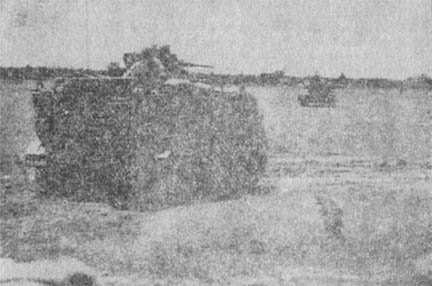 |
| Roaming the fields northwest of Cu Chi, 1/5th armored personnel carriers hunt for an elusive enemy. |
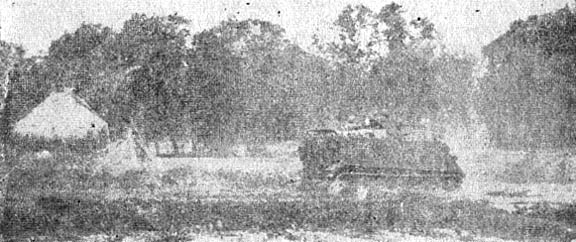 |
| Offering good protection for infantrymen against heavy Viet Cong infiltration in Ho Bo Woods, this 1/5th APC prepares to strike enemy positions in a tree line. |
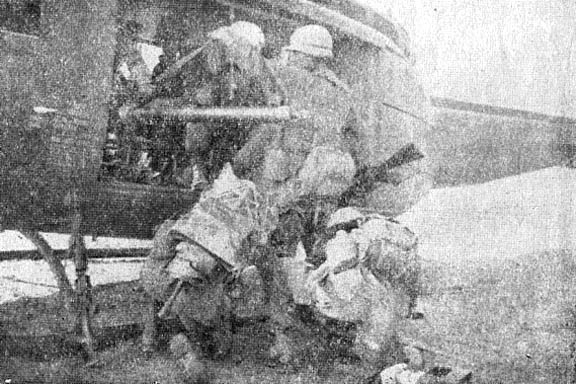 |
| "Flying horses" are loaded to helilift infantrymen into position during operation Kahala. |
 |
| Enemy positions routed, the UH1D helicopters touch down at the division helipad after operational mission in Trung Lap. |
Page 6 TROPIC LIGHTNING NEWS May 20, 1966
A reign of terror ended last week for more than 120 Montagnard villagers in
Kontum Province.
Several months ago, three Viet Cong, armed with submachine guns, entered the
village of Dak Lak, 30 miles northwest of Kontum. In short order, the three
machine guns became the law of Dak Lak.
From that time the VC - Mok, Mar, and Luk - virtually held the villagers
prisoner. All farming and work was done "under the gun." All production beyond
the minimum needs of the villagers went to caches for later use by VC forces
operating in the area.
The villagers were powerless to stand up against their captors. Dak Lak is
located in the midst of the most rugged terrain in Vietnam's Central Highlands.
Government forces rarely enter the area. American forces had never been in the
area - until last week.
About 3 a.m. the three VC were jolted out of their drowsy watchfulness by a
booming voice which seemed to come from all around them.
"VC, throw down your arms . . . villagers move east to Highway 14 and south
to Dak To refugee center," came the voice from the sky. A Vietnamese language
tape was being played over the powerful loudspeakers mounted in an American C-47
aircraft. Mok, Mar and Luk were visibly shaken, according to later reports of
the villagers.
The captors were further shaken on the next night when artillery rounds began
falling around the village at varying intervals.
Elements of the division's 3rd Brigade had moved into the town of Tan Carib,
a few miles to the south. The Americans scheduled artillery fires throughout
the night into likely targets in the Viet Cong-infested mountains.
When the villagers awoke the following morning, Mok, Mar and Luk were nowhere
to be seen. A quick check found them to be gone, along with their three
submachine guns.
Wasting no time, the residents of Dak Lak packed all they could carry and set
out for the highway, 15 miles to the east. They did not know what they would
find there. They only hoped that it would be better than what they were
leaving.
The Montagnards moved to the road, then south to the Dak To resettlement
center. There, protected by Vietnamese Army units, a 50-man government
reception team met them and began the task of resettling them.
The villagers were provided temporary quarters, enough rice to eat until they
were able to establish their crops, and medical assistance. The government then
assisted them with the advice and materials for construction of a new home near
Dak To. There they will be able to live in relative freedom from Viet Cong
terrorist actions.
The 120 Montagnards from Dak Lak were part of more than 1,500 refugees
brought into the resettlement center during operation Longfellow. Third Bde.
and 24th Special Tactical Zone(ARVN) troops worked hand-in-hand to help the
homeless Montagnards to get to Dak To. American and Vietnamese government
personnel will now work together to see that these people are no longer harassed
by the likes of Mok Mar and Luk.
Montagnard Children Get $140 Surprise
Thanks to a generous citizen of the "Aloha State," 60 primary school children
from the Montagnard of Tri Le found their life $140 richer last week.
The extra cash came to the school in an issue of Life magazine. The magazine
had been collected in the division's "Helping Hand" drive in Hawaii during late
February.
Thousands of articles of clothing and tons of soaps, school supplies, and
other items with civic action potential were donated by individuals and
organizations throughout the state to aid the division's civic action program in
Vietnam.
Many individuals, hearing that the Vietnamese like to look through picture
filler magazines, donated thousands of back copies. One individual donated a
copy of Life with a hundred dollar bill and forty dollars in smaller bills
tucked inside. The donor remained anonymous.
Staff Sergeant Hubert Keener, of Collinsville, Ala., presented a bundle of
magazines, which included the special issue of Life and some school supplies to
the Tri Le school on behalf of the 2nd Battalion, 9th Artillery.
One child came across some strange looking slips of green paper as he glanced
through one of the magazines. He showed his teacher, who recognized the small
fortune the little boy held in his hands.
The teacher turned the money over to Tri Le's village chief, who in turn had
it converted into piastres at the province capital in Kontum.
At their graduation exercises recently, the Tri Le school children were given
equal shares of the gift. For most it was more than they had ever seen at one
time, much less held as their own.
Fakers Join Ill at MEDCAP Visit
Almost like the neighborhood Good Humor man, the officer from the Vietnam
Information Service drove the tiny, three-wheeled Lambretta through the narrow
streets of Trang Bang, a quiet village about eight miles west of Cu Chi.
Even before the information service was beginning to perform its duties, two
medical corps officers from the 25th Infantry Division, Major Walter Wiitala and
Captain Paul Gagnon, both from 25th Medical Battalion, were already doing
theirs.
The MEDCAP team had treated the people of Trang Bang the previous day, and
when the children saw the Americans moving in again, the word spread quickly.
Organization at a MEDCAP can pose a problem, but the patients here were lined
up at the front door and given a number. Some still tried to infiltrate through
the rear door and promptly were led by the hand back to the front.
The bonafide patients received the traditional doctor's concern.
"I'll tell you what's wrong with this man now," Major Wiitala, of San
Francisco, Calif., stated, ignoring the interpreter. "His chest hurts, he
coughs, his knee hurts . . . He's got T.B. and it is quite advanced.
The interpreter confirmed the doctor's diagnosis. The doctor did his best,
prescribing a shot of penicillin and other medication to prevent additional
complications. "Give him some aspirin to get rid of the joint pain."
And so they filed in and out - skin rashes, cataract of the eye, fever,
stopped up nose, bronchitis, etc. There were even a few out-and-out fakers.
Major Wiitala ran into a little trouble with one tuberculin patient. He
prescribed penicillin and vitamins, but the patient, a man, refused to take the
shot or medication claiming he had taken Chinese medicine earlier in the day and
that the two medicines can't be mixed.
"I'll tell you what," Major Wiitala said, "You take this home with you and
start taking It tomorrow."
A young boy walked up to the major and motioned toward his mouth. For a
moment the doctor didn't catch on.
"What's wrong with you?" he said. "A toothache! Let me see."
A specialist pulled out a bottle of cloves, and the doctor fixed the tooth,
temporarily, that is.
"Next time we get a MEDCAP out here, I'd like to get a dentist to come
along," he said. "That tooth has to come out. I want her (the mother) to do
exactly what I did with this stick and cotton. Just stick it into his tooth and
that will stop it from hurting."
The doctor also handed the boy a tube of toothpaste, so he will have, in the
future, 23 per cent fewer cavities, and America may have 23 per cent more
friends.
| PRESENTATION - Sergeant First Class Raymond Carswell (l.), non-commissioned officer in charge of the division Helping Hand Operations Center, presents gifts from the people of Hawaii to Captain George Tamonaga, 25th Medical Battalion. The gifts are being given to patients in the hospital at the base camp. |
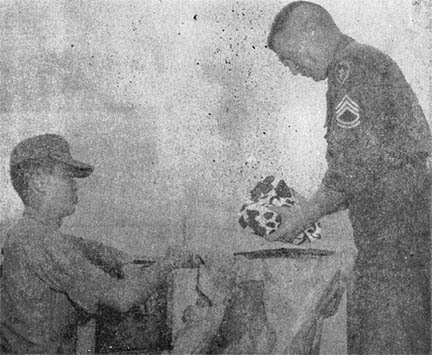 |
Villages Receive First American Medical Help
Four Montagnard villages never before visited by an American military medical
team recently received treatment from the medics of 3rd Brigade.
The village of Dak Rao Kuen, Kon Kotu Peng, Kon Kotu Lop, and Dak Kang Lop,
located in the central highlands of Vietnam, eagerly received the team, which
was led by Captain William R. Gardner, of Jacksonville, Fla.
The villagers had been informed by the local Vietnamese district chief that
the American team was coming. In anticipation of the American's arrival, the
villagers cleared helipads from the forest and prepared entertainment for their
visitors.
Two helicopters shuttled the team of eight medics and civil affairs personnel
into the villages. Each visit lasted between an hour and an hour and a half.
While Capt. Gardner and his team of medics, 1st Lieutenant Larry R. Suit,
from Monett, Miss., and Specialist Six Hurlie Cook, from Chula Vista, Calif.,
cared for the sick, Captains Richard B. Daluga and Stanley J. Zagalak, the
sub-sector advisors, passed out candy and taught the young villagers to count in
English.
First Lieutenant Francis W. Grothe, of York. Pa., the civil affairs assistant
team chief, 2nd Lieutenant Tein, Vietnamese deputy district chief, and Master
Sergeant Bui, medic/interpreter, assisted in the treatment.
In gratitude for the Americans' aid, the team was presented bracelets from
the villagers. In Dak Kang Lop the villagers prepared roast chicken and rice
for their visitors.
Page 7 TROPIC LIGHTNING NEWS May 20, 1966
Liaison Officers Act As Vital Handymen
Liaison officers are not authorized to make mistakes, and 1st Lieutenant
Willie Williams, the coordinator between 1st Battalion (Mechanized), 5th
Infantry and the division's 2nd Brigade, hasn't exceeded his authorization.
In the fight against the Viet Cong, Lt. Williams is one of many officers
performing a vital, if somewhat unpublicized function.
It is the responsibility of battalion liaison officers to know where the
battalion is located while in action, to know what they are doing and to keep
higher command informed of all their activities. Additionally, he carries all
plans and orders too complicated or sensitive to transmit by ordinary
communications.
Since one slight mistake in location could rain artillery in on friendly
forces, the duties of the liaison officer are of special importance. When
friendly forces fall under enemy fire, the liaison officer is present to pinpoint
the exact location of friendly forces in case of questions.
Lt. Williams, one of two 5th Mech. liaison officers, has been on the job for
his battalion since the 2nd Bde. moved to Cu Chi in January, and he realizes its
importance.
"You aren't allowed to make one mistake in combat," he said, "especially when
you're liaison officer. If I were to make a mistake, such as reporting an
incorrect position for American forces, it could cause many friendly casualties.
On a few occasions, Lt. Williams, using his personal judgment, may have
saved a number of lives.
Normally, the responsibility of calling in artillery fire or air strikes to
aid American troops belongs to the battalion commander, who circles the action
in a command and control helicopter (C and C).
On rare cases. however, the C and C ship is not in a position where air
strikes or artillery can be requested.
During operation Circle Pines near Ho Bo Woods, a long-time Viet Cong
stronghold, a company of 1/5th came under fire while the C and C ship was out of
the area. Lt. Williams stepped in and went to the forward air control center,
reported enemy positions and had air strikes called in.
On another occasion, the battalion ran into Viet Cong fire late in the day.
Since it was becoming dark, the lieutenant saw the need for battlefield
illumination and notified the Air Force liaison officer. A quickly dispatched
flare ship provided enough light for the units to maneuver against the enemy.
The 5th Mech. recognizes the value of the liaison officers and even named one
operation after Lt. Williams' home town, Del Ray Beach, Fla.
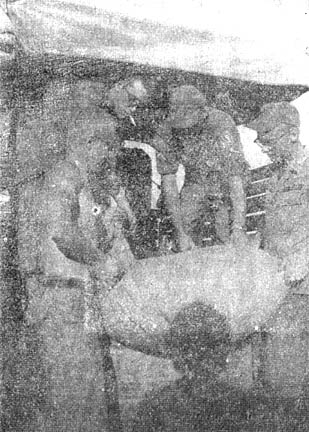 |
BOOTY- Men of Company, B. 1st Battalion (Mech.), 5th Infantry, load rice on a recent mission onto a truck, which will carry it to villages around Cu Chi. Specialist Four Richard Durivage (left foreground), of Waterford, N.Y., and Specialist Four Anthony Paudicz, Marysville, Ohio, lift a 50-kilo (about 100 lbs.) bag of rice onto a truck where PFC Kenneth Stewart (left lop), Kansas City, Mo., and PFC Larry Hensley, Sciota, Ill., secure the rice for shipment to needy villages. (Photo by Carollo) |
Large Payday Means Big Job
Payday! The magic day which gets almost holiday-like attention from soldiers
everywhere - and members of 3rd Brigade are no exception.
Paymaster for the "Bronco Brigade" is 1st Lieutenant Joe Morgan, of Laurel,
Miss. Assisted by twelve enlisted men, Lt. Morgan's job is to see that every
man in the brigade is paid each month.
No small job this, brigade payroll approaches about $720,000 a month.
However, the figure swells another $150,000 to $870,000 after travel vouchers
and temporary duty per diem are paid.
Since 3rd Bde's arrival in the Pleiku area, the finance office has had the
problem of paying the soldier in the field. Lt. Morgan and several of his men
solved that by taking the payroll to the troops. At the forward area, they set
up a disbursing point, where the unit pay officers are able to pick up the money
for their men.
Not only does the finance office pay the troops, they convert about $15,000 a
month in Military Payment Certificates to American currency for individuals
going on rest and recuperation trips and returning to Continental United
States. They also convert from $20,000 to $30,000 in MPC to Vietnamese piastres.
Complacency Helps Viet Cong
By Capt. John D. Dewar
Complacency: the single, greatest danger to survival in the face of an
ever-watchful enemy. It is as great an adversary as sniper bullets and hand
grenades. It could mean your death.
The National Liberation Front maintains an effective and elusive
intelligence, espionage and sabotage structure, and it is easy to overlook the
fact that such an organization operates in the Cu Chi area. It is quiet,
stealthy - and deadly.
Always on the lookout for a means to a major combat victory, the Viet Cong
also bend their efforts in the direction of smaller assaults upon the division's
base of operations in order to confuse and demoralize.
These small scale assaults are called victories of opportunity. The VC can
inflict damage only when they have the opportunity, so they might also be called
defeats of complacency.
It must be remembered that although the division's presence has had a
beneficial impact in the area, Cu Chi and the surrounding towns of Tan An Hoi,
Vinh Cu, Phuoc Vinh Ninh, Tan Phu Trung, Trang Lam and Bao Cap long have been a
VC stronghold. Much of the population is illiterate and VC propaganda was their
only source of education.
Consequently, many of the area's inhabitants remain capable of hostile
partisan activities. The security section has found such activities to be
limited only by the ingenuity and imagination of enemy agents.
VC subversive agents, acting as the businessmen, vendors, taxi drivers,
restaurateurs and prostitutes that anyone is likely to encounter whenever
leaving base camp, are constantly trying to learn the strength, location,
disposition, movement and combat efficiency of the division. In collecting all
details - meal times, guard tours, names of dissatisfied individuals, data on
personnel susceptible to blackmail, names of relatives who send mail - the VC
can make plans for terrorism, sabotage, psychological warfare, or surprise
attack which will have the highest propaganda value.
Several reports have indicated that VC are dressing in fatigue uniforms with
Army of the Republic of Vietnam (ARVN) identification. The last incident
reported occurred three miles from Cu Chi when a squad-sized element,
appropriately disguised, entered an ARVN outpost and killed several soldiers
before being driven out.
Non-military personnel who have access to the division area as laborers and
hired help are, in most cases, people who have lived in the area, or even the
base camp location itself, for most of their lives. They are fully capable of
noting control points, communications facilities, water points, motor pools,
helipads, etc.
One man left his weapon to go into a rural house of prostitution. When he
emerged, he found his weapon in the hands of a native. Result: one U.S. KIA.
Unfortunately, an enemy agent can be the most innocuous of people. While he
is busily gaining confidence, he is collecting information and supplying the VC
with the wherewithal to launch a major surprise.
While this agent is busy winning the unwitting confidence of U.S. military
personnel, he is equally busy forcing the people into a "coerced friendship."
Acts of terror, ambush, sniping or small scale sabotage against U.S. personnel
increases the fear - and control - he has over the people. In turn, they become
his sources of information in exchange for his political protection racket.
Collaboration is complacency's greatest ally. Together, they work to produce
the results the Viet Cong want.
The complacent and unwary soldier is a prime VC target; he could be dead.
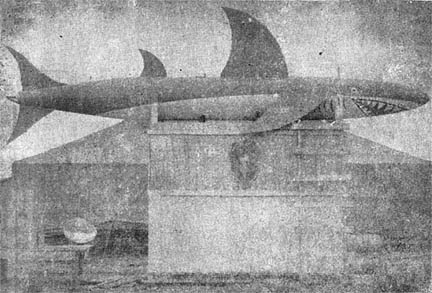 |
FUEL TO WATER - Not the entrance to a fish market, this airplane fuel tank serves as a shower for the officers of Headquarters and Headquarters Company, 25th Division. It is one of many impromptu showers rigged up around the Cu Chi base camp, fashioned from oil drums, water cans or virtually anything that will hold water. |
Page 8 TROPIC LIGHTNING NEWS May 20, 1966
U.S., ARVN Troops Work for Victory
"The only way to measure success in this war is to see how many people you
return to the influence of the Vietnamese government," said Lieutenant Colonel
Clay T. Buckingham, of Vero Beach, Florida.
"To do this," continued the chief military adviser to Vietnamese forces in
Hau Nghia Province, initially we must have a dual force of both Vietnamese and
Americans. Only their own people can tell the villagers why the Americans have
come. Only Vietnamese themselves can dispel Viet Cong rumors."
This dual force concept was used for the first time by the division on
operation Maili. Meetings are conducted daily in the province capital of Bao
Trai between Col. Buckingham., Lieutenant Colonel Harley F. Mooney Jr., 1st
Battalion, 27th Infantry, commander, and Major Nguyen Van Nha, the province
chief.
Simply stated, the operation involves U.S. forces moving into and clearing an
area, while troops from the Army of Vietnam (ARVN) join other Vietnamese to go
in and perform what Col. Buckingham calls "the bedrock function of
pacification."
The pacification team includes Vietnamese medics, who operate in a manner
similar to the U.S. Army's Medical Civic Action Program and National Police.
The teams search each hooch, take a census and gain intelligence data, which,
according to Captain James J. Kernan, of Youngstown, Ohio, the province S-3
adviser, "we couldn't get any other way except by sitting down and talking with
the people."
The team also effects a psychological function which is probably as effective
as helicopter loudspeakers.
Units of the 1st Battalion, 27th Infantry, were augmented by ARVN soldiers
throughout operation Maili. Twenty Vietnamese sector special troops are divided
among the line units for both day and nighttime action. Two or three regular
Vietnamese troops go out on each of the nightly squad ambushes. In addition,
entire battalions from the ARVN 25th Division are employed in offensive and
blocking roles.
All members of the advisory team agree that this close contact between ARVN
and American forces is resulting in a mutual respect for each others knowledge
as well as personal friendships between the men.
What have been some of the tangible results of the combined operation in Hau
Nghia Province?
"The most obvious," said Col. Buckingham, "is that the hamlet of Duc Hanh 'B'
has three times as many people as it did two weeks ago. It's been overrun three
times, and it wasn't until now that we could provide enough security to build a
new outpost. We've given people a sense of confidence and security they haven't
had before.
"Finally, we've discredited the VC by showing that U.S. and Vietnamese forces
can operate almost with impunity in an area that once had three VC battalions
ready to attack at any time."
McDonough Becomes CO of Co. A, 2/35th
Captain James McDonough, of Portland, Maine, became the new commander of
Company 'A', 2nd Battalion, 35th Infantry, in ceremonies last week at the 3rd
Brigade's base camp.
The previous commander, Captain James E. Barnes, of Oklahoma City, Okla., is
the new battalion adjutant. He has been commanding officer of Company 'A' for
eight months and has led his men on several operations against the Viet Cong
since the brigade arrived in Vietnam last December.
A parting "aloha" to Capt. Barnes and a welcoming one to Capt. McDonough were
given by the men of the company, who threw an authentic Hawaiian luau. The luau
was complete with a pig on a spit and one baked in the ground in a traditional
Polynesian imu.
3rd Bde. Opens New Hospital
Members of the 3rd Brigade Task Force recently participated in dedication
ceremonies for the new Pleiku Provincial Hospital.
The project originally began when the province chief gave the town of Pleiku
the buildings of a former Vietnamese Special Forces billeting area. Much of the
reconditioning of the buildings was done by the 41st Civil Affairs Team,
attached to 3rd Bde. The hospital has a 100-bed capacity.
Total expenditures for the hospital project reached more than 150,000
piastres, plus the personal sacrifice and hard work of the people.
Members of the 3rd Bde. are holding their heads a little higher now with the
feeling of a job well done. The feeling was expressed by Brigadier General
Glenn D. Walker, task force commander, when he said, "This renovated hospital is
indicative of the friendship and cooperation which exists between the people of
South Vietnam and the People of the United States. I am confident that this
hospital will exemplify the cooperation which exists between the people of South
Vietnam and the people of the United States. I am confident that we will see
much more evidence of that friendship and cooperation in the future.
| GRAND OPENING - Brigadier General Glenn D. Walker, CG, 3rd Bde., presents plaque to Lt. Col. Ho Vinh, Pleiku Province Chief, at dedication ceremonies of Pleiku Hospital which 3rd Bde. personnel helped renovate. (Photo by Sutphin) |
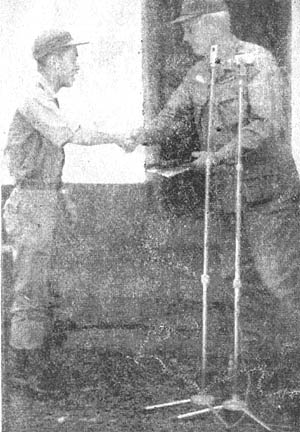 |
Thanks to:
The 25th Infantry Division Museum for providing the volume of 1966 Tropic
Lightning News,
Ron Leonard, 25th Aviation Battalion for finding and mailing them,
Kirk Ramsey, 2nd Bn., 14th Inf. for creating this page.
This page last modified 09-08-2006
©2006 25th Infantry Division Association. All rights reserved.